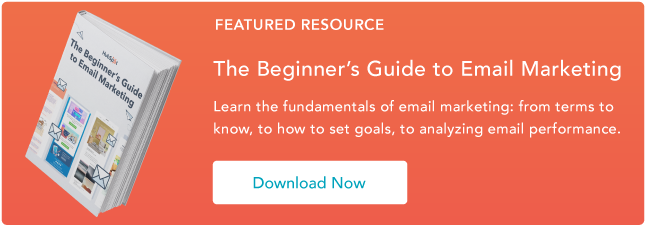You’ve made it through multiple rounds of interviews, the hiring team has selected you as their top candidate, and they’ve made you an offer. But you aren’t quite satisfied with all of the terms. This is where a counteroffer comes in.

Counteroffers are expected. If you haven’t written a counteroffer email before or feel like it’s not something you need to do, it may be time to reconsider.
According to a survey from Fidelity Investments, 85% of people who make a counteroffer receive at least some of what they negotiated. This can include an adjustment to the salary, terms, or benefits.
If you’ve never written a counteroffer email, you probably don’t even know where to start. Below, I’m breaking down exactly what a counteroffer is and how to make one. I also asked ChatGPT to help write a few counteroffer emails to give you an idea of what one looks like so you can start practicing writing your own.
What is a counteroffer letter?
A counteroffer letter is a letter, typically an email, that candidates send to a hiring team to negotiate the terms of a job offer. A counteroffer email is sent before formally accepting a job offer as part of the negotiation process. Counteroffers can negotiate any part of the offer, from the base salary to bonuses to work schedule.
How to Give a Counteroffer
To understand exactly how to write a counteroffer email, I spoke with Sarah Johnston, founder and CEO of executive resume writing and interview coaching firm Briefcase Coach. Here are the steps she recommends following when you have an opportunity to give a counteroffer.
Affirm you want the role.
Before you state your counteroffer, you need to affirm that you want to move forward with the company. Start by letting the recruiter or hiring manager know that you appreciate the offer and you’re excited about the opportunity to work at the organization.
Johnston also suggests emphasizing the knowledge you have about the role and the company.
“The more specific you can be about the passion you have for the mission or projects that you’ll be contributing to, the better,” she says.
Negotiate a specific counteroffer.
After you emphasize your desire to work with the team, it’s time to negotiate. Your negotiation should be clear and specific and outline the terms you want to adjust.
And don’t forget — the salary isn’t the only part open to negotiation. Your counteroffer can be about the benefits or other terms that contribute to your work-life balance, like your schedule.
“The negotiation period is a great time to ask for remote days as well as a non-traditional schedule,” says Johnston. “I recently had a client negotiate to start her day at 7:00 am so that she could leave by 3:00 p.m. to pick up her kids from school.”
Explain your justification.
Follow up your negotiation with a brief explanation that demonstrates you’ve done your research. Showing that you have given your counteroffer thought and have done market research helps prove not only how committed you are to the role, industry, and organization but also that you’re confident in what you bring to the table.
Johnston recommends framing your counteroffer like this:
“According to my market research, this position should pay between $75-92K a year. The offer of $76K that you presented falls in the low range for the position. I bring 10 years of experience to the table, and my compensation should reflect the depth and breadth of knowledge that I can offer. Additionally, the cost of living index for this area is one of the highest in the country. Based on my experience and qualifications, I think a salary of 85K would be more appropriate.”
Wrap up with final remarks.
Finally, wrap up your email by thanking the recruiter or hiring manager for their time and consideration. This could be the beginning of a new work relationship, so it’s important to remain professional and kind. The last thing you want is to be confrontational and end up hurting your chances of securing the job.
What ChatGPT Wrote Me: 5 Counteroffer Email Examples
I was curious to see if AI could help me write a counteroffer email that I could use in the interview process.
For this example, I found a job posting for a Field Marketing Manager at Wings and Rings, a restaurant franchise.
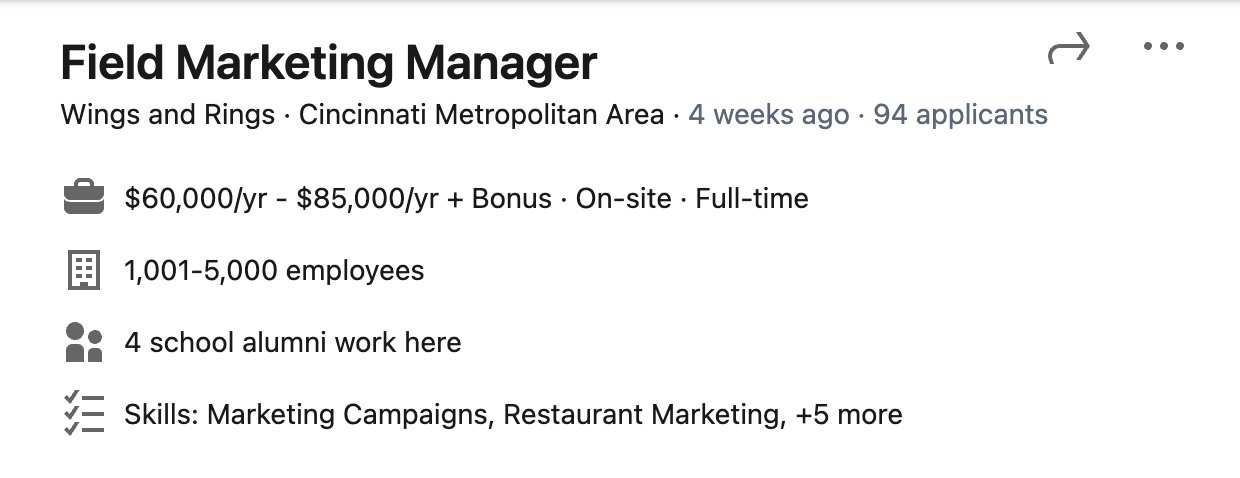
1. Counteroffer Email Example: Salary Negotiation
For my first prompt, I’m going to assume the company offered me a salary at the low end of the salary range, $60,000. My counteroffer will be $75,000. Here is the first prompt I gave ChatGPT:

And here is the counteroffer email that it came up with:
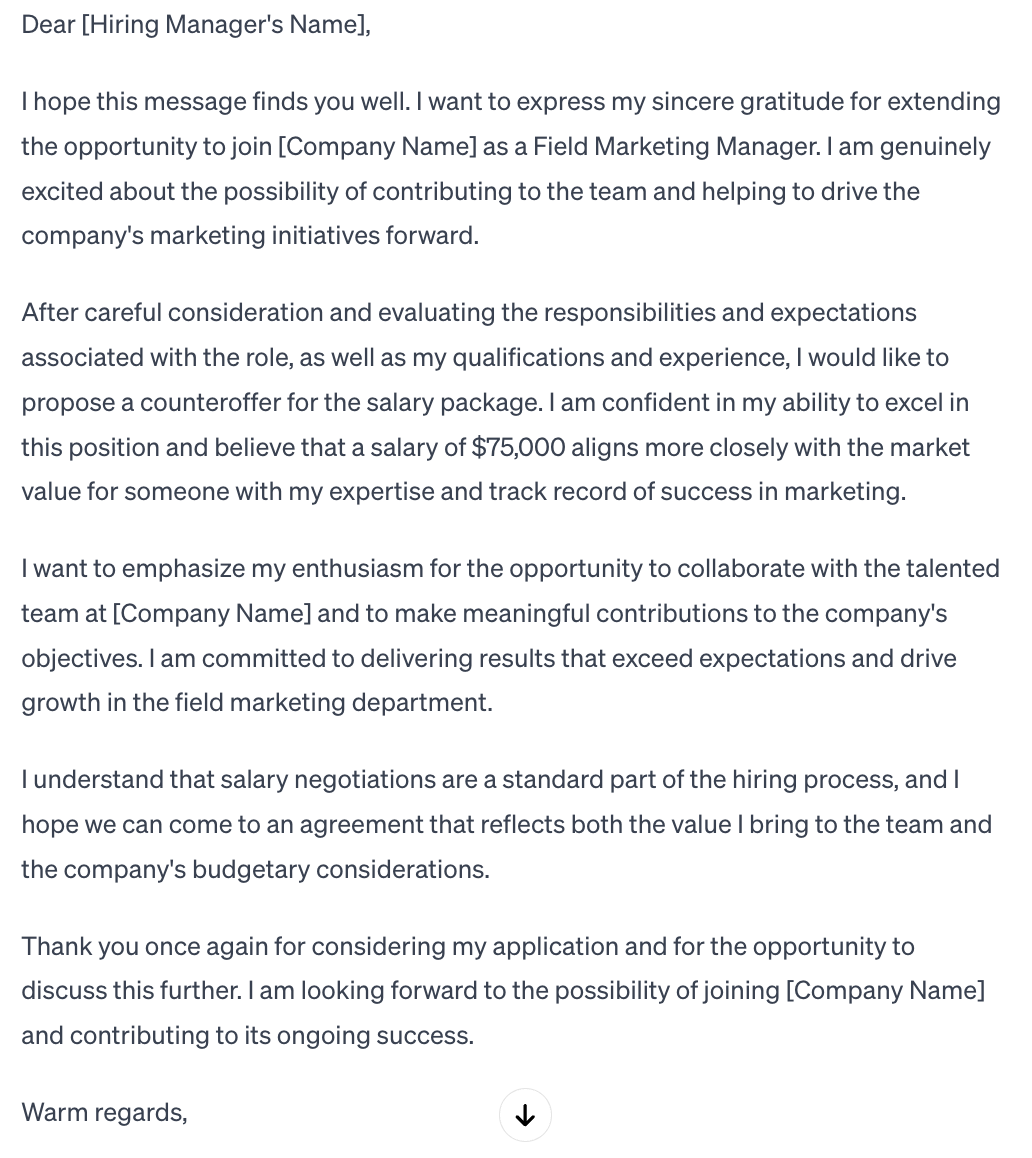
While this email is on the longer side, it gets a lot of things right. The email begins by stating an appreciation for the job offer and an emphasis on why they’re excited to join the company.
The next section briefly touches on the candidate’s qualifications and why they’re proposing a counteroffer. The email then reiterates their enthusiasm for the opportunity and how they will contribute to the position.
If it were me, I’d remove the second to last paragraph. I don’t think it’s necessary to say, “I understand that salary negotiations are a standard part of the hiring process,” because the hiring manager is well aware of that already.
What I like: I like how the email communicates enthusiasm for the position before and after the counteroffer. In my experience, this shows that the candidate is taking this offer seriously and is eager to come to an agreement.
2. Counteroffer Email Example: Market Research
I want to see if ChatGPT can create a similar counteroffer negotiating a higher salary, but this time, I want to show that I’ve done my research.
Here’s the prompt I gave ChatGPT:

And here is the email it generated. I highlighted the main difference between this email and the last.
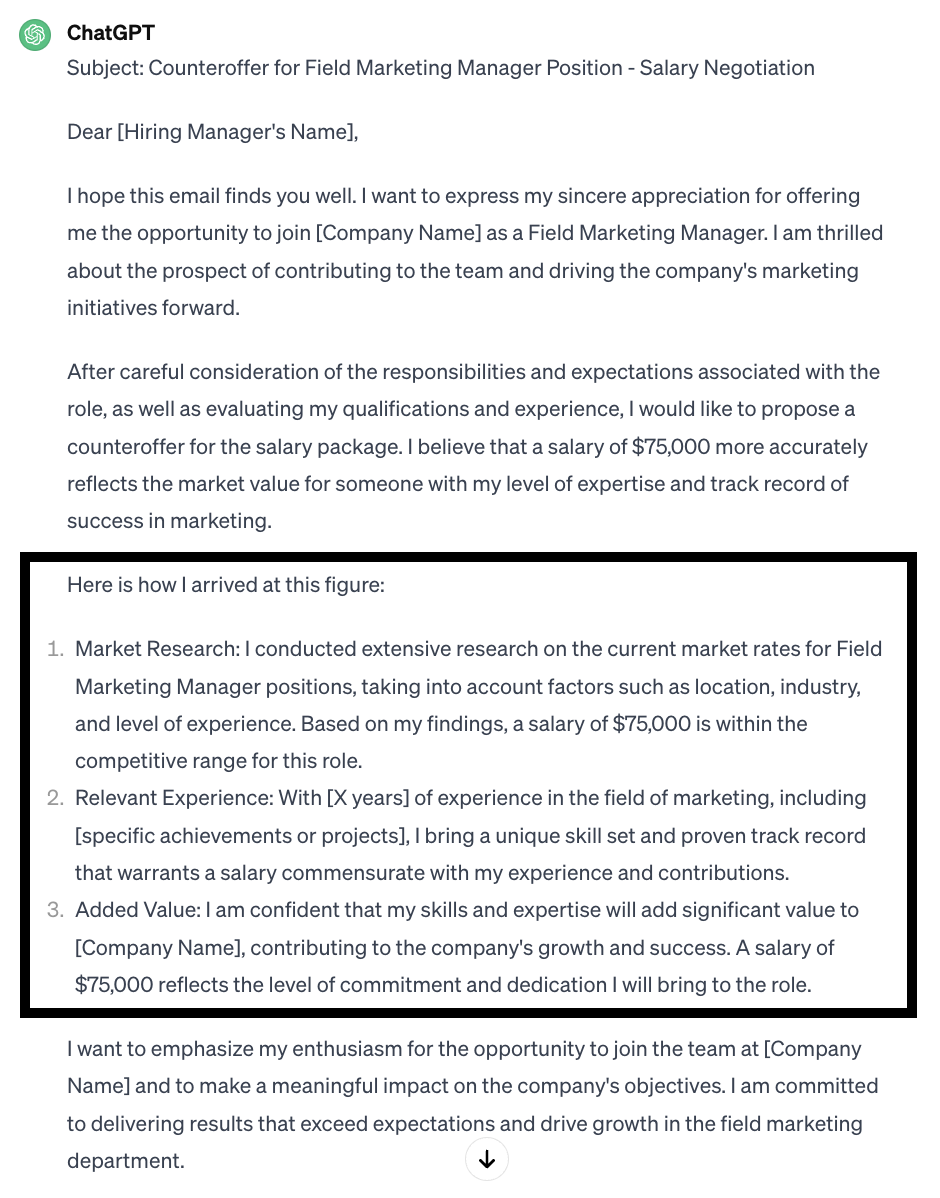
This email is similar to the script Johnston provided when she shared her tips for writing a counteroffer email. It demonstrates that a lot of research has gone into this counteroffer, and I didn’t just request a random number.
The rest of the email could stand to be edited down, but overall, I think a strong point was made.
What I like: Using a numbered list makes the email easier to scan and digest.
3. Counteroffer Email Example: Benefits Negotiation
For my next prompt, I want my counteroffer email to negotiate a different work structure. Since this is an on-site field marketing position, we can assume that the work schedule would involve a lot of travel to different franchise locations. I want my counteroffer to negotiate having one day be remote or work from home.

I was curious to see how ChatGPT would frame this negotiation since it’s not about money. Here’s what the chatbot came up with:
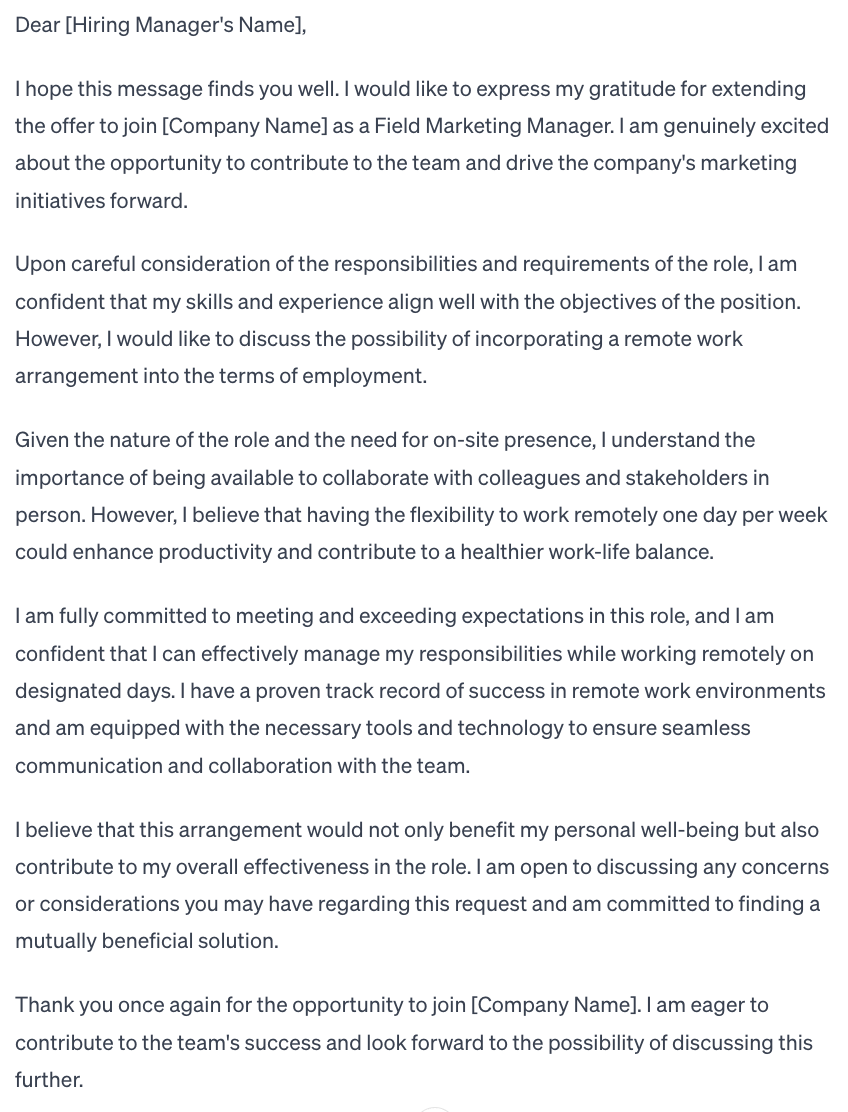
Overall, I think this is a strong counteroffer email. Not only does it communicate enthusiasm for the offer, but it provides a strong rationale for remote work.
The email thoroughly describes the situation and shows an understanding of why the role needs to be primarily onsite. But the message also includes a line about the candidate’s proven track record in remote work environments, which reassures the hiring team that there won’t be an issue with this setup.
What I like: My favorite line is, “I believe that this arrangement would not only benefit my personal well-being but also contribute to my overall effectiveness in the role.” This outlines the benefit for both the candidate and the hiring team, communicating that the candidate will perform better overall if they have a more flexible work arrangement.
4. Counteroffer Email Example: Relocation Assistance
For my next prompt, I want to send a counteroffer that negotiates relocation assistance. The Field Marketing Manager role I’m using for this example is based in Cincinnati, Ohio, and I currently live in Austin. If I got an offer, I’d need to relocate. Here’s the prompt I gave ChatGPT:

Here’s the counteroffer email ChatGPT generated:
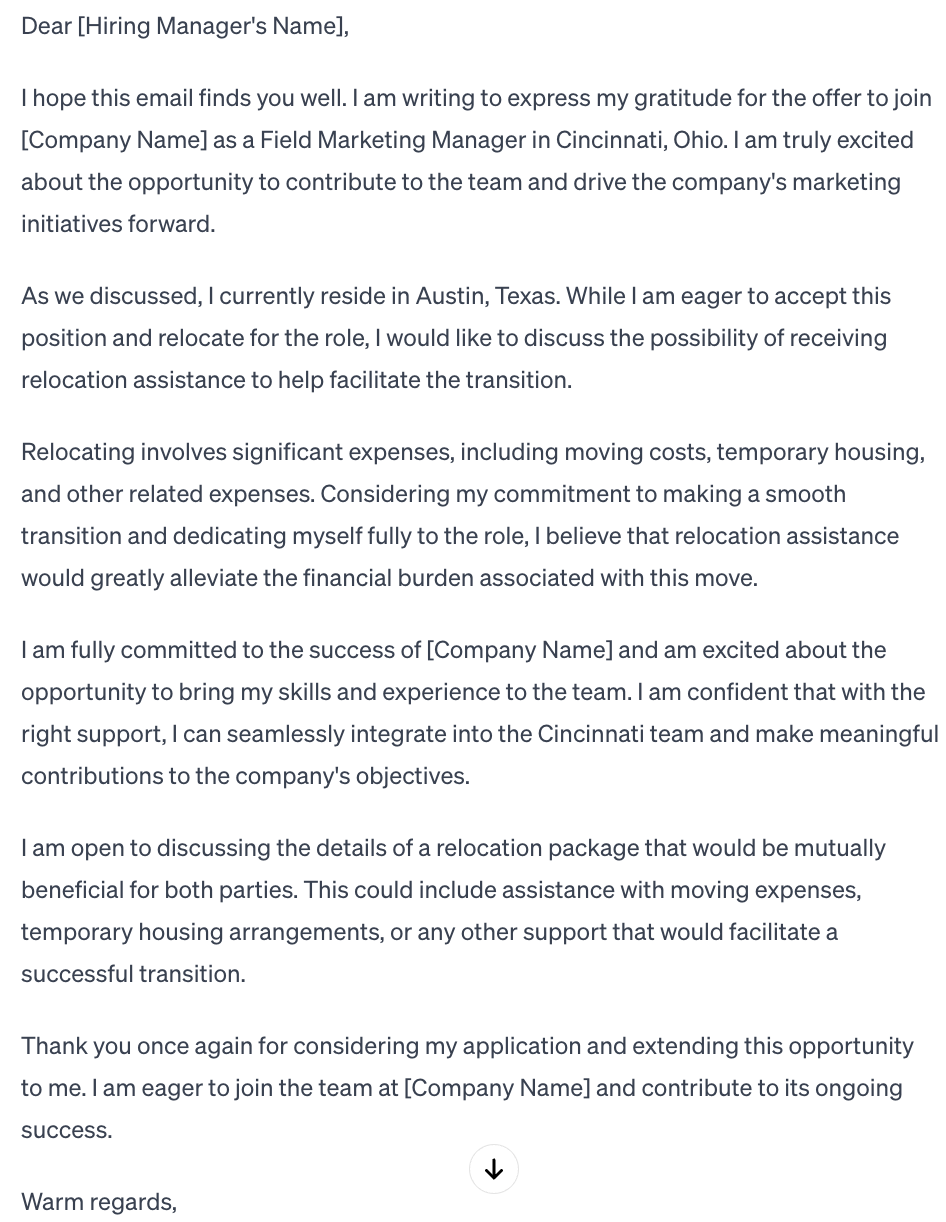
If I were this far along in the interview process, the hiring team should already be aware that I would need to relocate for the job. However, if they didn’t already include relocation assistance in my job offer package, this counteroffer email would be a strong way to negotiate.
What I like: I appreciate that the email is specific about what expenses I’d need assistance with, including moving costs and temporary housing. I also like that the email says this line to justify the counteroffer: “Considering my commitment to making a smooth transition and dedicating myself fully to the role…”
5. Counteroffer Email Example: Short Email
I noticed that all of the responses ChatGPT generated were long. I was curious what the email would look like if it were more concise, so I asked the chatbot to make it shorter. Here’s what it generated:
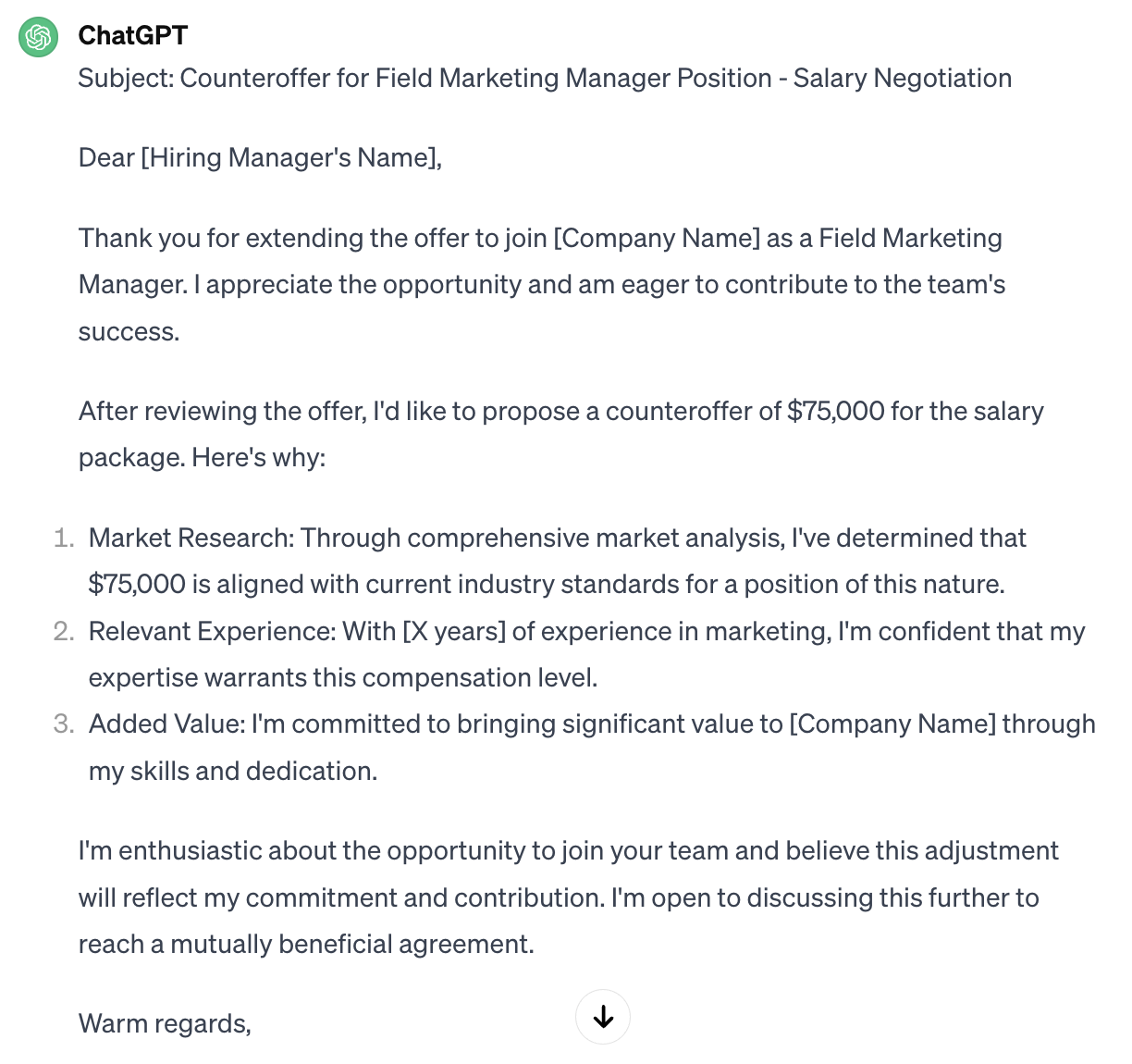
This is probably the closest to a send-ready email that ChatGPT has generated so far. It’s more straightforward and succinct while still outlining the essential parts of a counteroffer email. If I were actually about to send a counteroffer for a job, I’d be comfortable using this email (after some light editing to align with my voice).
What I like: The numbered talking points are briefer than in previous emails, but they still make a strong point and demonstrate that I’ve done my research.
What I Learned from AI
In my opinion, ChatGPT generated some pretty decent counteroffer emails. The structure and talking points of these emails aligned with the tips Johnston shared, indicating that ChatGPT is familiar with counteroffer best practices.
And, while I didn’t prompt ChatGPT to use a certain tone or style for this experiment, you can get more specific with your prompts if you want to generate a counteroffer email that aligns more with your voice.
If you want to use AI to assist in writing emails during the job search process, I’d use ChatGPT for practice rather than for your actual email to the hiring team.
You can conduct a similar exercise to the one I did by giving the chatbot multiple prompts for different negotiation scenarios. Writing and refining your prompts helps you narrow down what you’re willing to negotiate on and the terms you may be less flexible about.
Overall, AI works well for crafting a solid counteroffer email structure, but it’s up to you to conduct research, come up with a desired salary, and confidently pitch yourself.
Making Your Counteroffer
Making a counteroffer is an anticipated part of the interview process. Prepare ahead of time by practicing writing counteroffer emails. Preparing what you would negotiate in different scenarios can help you clarify your desired salary and non-negotiables and help you improve how to justify the counteroffer and communicate your value.
By practicing your script and following the expert tips above, you can write an effective counteroffer email that helps you land a job with a salary and benefits package that you’re satisfied with.
- SEO Powered Content & PR Distribution. Get Amplified Today.
- PlatoData.Network Vertical Generative Ai. Empower Yourself. Access Here.
- PlatoAiStream. Web3 Intelligence. Knowledge Amplified. Access Here.
- PlatoESG. Carbon, CleanTech, Energy, Environment, Solar, Waste Management. Access Here.
- PlatoHealth. Biotech and Clinical Trials Intelligence. Access Here.
- Source: https://blog.hubspot.com/marketing/counter-offer-letter


![→ Download Now: The Beginner's Guide to Email Marketing [Free Ebook]](https://zephyrnet.com/wp-content/uploads/2024/03/i-asked-chatgpt-to-write-5-types-of-counteroffer-emails-heres-what-i-got-1.png)
